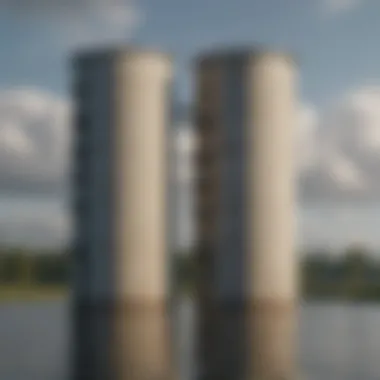Understanding Reservoir Towers: Essential Water Management Structures


Overview of the Topic
Reservoir towers are critical structures in the management of water resources. As part of larger reservoir systems, they play a fundamental role in regulating water supply and quality for urban and rural areas. These towers allow for the effective distribution of water, balancing the demands of users and the natural environment. In light of increasing population stresses and climate change, understanding their design and function has become increasingly essential.
The significance of reservoir towers extends beyond mere water storage. They are integral to flood control, irrigation systems, and enhancing the ecological balance of local environments. Their construction and operational methods can also significantly impact nearby ecosystems, necessitating careful planning and consideration.
Current Status and Challenges
Currently, many regions face challenges that affect the effectiveness of reservoir towers. Issues such as aging infrastructure, sedimentation, and pollution are common. These factors can lead to reduced capacity and compromised water quality.
Climate change presents another formidable challenge. Altering precipitation patterns affect water availability. Cities must adapt to these shifts, securing their water sources while maintaining environmental integrity.
"Reservoir towers are vital in managing one of our most precious resources: water. Their design impacts our ability to respond to climate challenges."
Sustainable Solutions
To mitigate these issues, there are several sustainable practices that can be implemented. Innovations in tower design, such as scalable and modular systems, offer improved adaptability to changing conditions. Regular maintenance is essential to prolong the life of existing infrastructure and reduce the need for new constructions.
Case studies from areas implementing green infrastructure provide insight into effective water management. For instance, the design of the Lake Mead Reservoir in the U.S. incorporates advanced technologies for monitoring water quality and quantity.
Impact and Importance
The impact of reservoir towers is profound. They not only affect local communities but also influence larger ecosystems. Properly managed water resources contribute to sustainability and resilience against future environmental stresses.
Conservation efforts must prioritize the enhancement of these structures. Increased awareness and action can prevent potential water crises and ensure a reliable supply for generations to come.
Preface to Reservoir Towers
Reservoir towers serve a pivotal role in the infrastructure of water management systems. Understanding these structures is crucial for professionals and students in fields related to environmental science, urban planning, and civil engineering. Not only do these towers facilitate effective water storage and distribution, but they also support a range of essential functions that ensure water quality and availability in both urban and rural settings.
Definition and Purpose
A reservoir tower is essentially a tall structure that holds water at a significant height. The primary purpose of these towers is to store water while providing necessary gravitational pressure for its distribution. This design allows for efficient water delivery to consumers, reducing energy costs associated with pumping systems. Additionally, these towers act as a buffer during peak demand times, ensuring consistent water flow.
Besides storage and distribution, reservoir towers can influence water temperature and quality. The height of the tower permits stratification, which separates warmer and cooler water layers. This helps maintain an optimal temperature for the water, which is important for preventing algae growth and maintaining aquatic ecosystem health.
Historical Context
The history of reservoir towers intertwines with the development of municipal water supply systems. Early civilizations, like the Romans, pioneered the construction of aqueducts and elevated tanks to store and distribute water. This method laid the groundwork for modern reservoir design. As cities expanded during the industrial revolution, the need for reliable water sources became paramount.
By the late 19th and early 20th centuries, water tower construction evolved significantly. Engineers began to utilize steel and reinforced concrete, allowing for taller and more durable structures. The introduction of new materials resulted in an increased focus on capacity and resilience. Today, these towers can be found in various forms, adapted to meet specific community needs.
The significance of reservoir towers in minimizing water wastage and supporting urban expansion cannot be overstated. They reflect ongoing advancements in engineering while highlighting the enduring quest for efficient water management solutions.
Structural Design of Reservoir Towers
The structural design of reservoir towers is a critical component of water management systems. These towers serve various functions, including storing, regulating, and distributing water. A well-designed reservoir tower ensures efficient operation and durability. The design process considers factors like materials, architectural elements, and common design trends that suit specific needs. Understanding these elements enhances the functionality and lifespan of these structures.
Materials Used
The choice of materials is significant in the construction of reservoir towers. The common materials include concrete, steel, and reinforced polymers.
- Concrete: Often used for its strength and durability, concrete withstands extreme weather and heavy loads. It also offers low maintenance costs over time.
- Steel: Known for its high tensile strength, steel allows for more slender designs. However, it requires protective coatings to prevent corrosion.
- Reinforced Polymers: These materials can reduce weight while providing good resistance to environmental impacts. They are gaining popularity for small-scale and innovative designs.
Selecting the right material depends on factors such as environmental conditions, cost, and expected lifespan. Engineers must carefully evaluate these aspects to ensure optimal performance.
Architectural Considerations


Architectural considerations in reservoir tower design include functionality, aesthetics, and integration into the surrounding environment. A balance among these elements is essential.
- Functionality: Engineers must design towers to meet specific water volume and pressure requirements. This affects dimensions and internal configurations.
- Aesthetics: While primarily functional, the towers should harmonize with their surroundings. This can involve tailored designs that reflect local architectural styles.
- Environment Integration: Designs should minimize disruption to local ecosystems. Using colors and materials that blend with nature can help in this regard.
Effective collaboration between architects and engineers can lead to a structure that is both useful and visually appealing.
Common Designs
There are several common designs in reservoir towers, each serving unique functions and varying based on location and usage.
- Vertical Towers: These designs maximize height to achieve better pressure regulation. They are common in urban settings where space is limited.
- Hydraulic Towers: Specifically engineered for pressure management, these designs help manage fluctuating demand during peak periods.
- Gravitational Towers: These utilize gravity to aid water flow, making them energy efficient. They are suitable for rural applications where natural topography supports such designs.
These design variations reflect the adaptability of reservoir towers to meet different needs and constraints while facilitating effective water management.
Functions of Reservoir Towers
Reservoir towers play a vital role in the effective management of water resources. They serve several functions that are crucial for ensuring a reliable water supply. These functions contribute significantly to the overall effectiveness and efficiency of water management systems. By understanding how reservoir towers operate, one can appreciate their importance within both urban and rural settings.
Water Storage
One of the primary functions of reservoir towers is water storage. These structures are designed to hold large volumes of water, which can be supplied to municipalities, agricultural lands, and industrial areas. The elevated position of reservoir towers allows for gravity-fed distribution systems. This means that water can be delivered efficiently without the need for extensive pumping, reducing energy costs and ensuring a steady supply.
The design of these towers accommodates variable storage needs. For example, during heavy rainfall periods, towers can capture excess water, thus preventing flooding in local areas. Conversely, in drier seasons, they ensure a reliable water source. This flexibility is essential for adapting to changing environmental conditions.
Pressure Regulation
Another critical function of reservoir towers is pressure regulation. They help to maintain consistent water pressure in distribution systems. When water is stored at a height, gravity creates pressure that can push water through pipes. This pressure is crucial for ensuring that water reaches all users without interruption.
In urban environments, where demand can change rapidly, reservoir towers serve as buffers. They can absorb peak demands during high usage times, helping to stabilize pressure levels across the system. This is particularly important during events such as fire emergencies or during dry spells when demand surges unexpectedly.
Distribution Systems
Reservoir towers are integral to effective distribution systems. They facilitate the movement of water from storage to users with minimal loss in quality and pressure. The height of the towers plays a decisive role in this. By elevating the water, it can flow naturally into surrounding areas.
In addition, modern engineering practices integrate advanced technology in distribution systems. Sensors are often placed in and around reservoir towers to monitor flow rates and water quality. Such technology allows for real-time adjustments to distribution based on demand and provides crucial data for maintaining water standards.
Reservoir towers are not just storage facilities; they are essential components of holistic water management strategies that cater to both immediate and long-term supply needs.
In summary, the functions of reservoir towers extend far beyond simple water storage. They are key players in pressure regulation and distribution, ensuring that water management systems operate efficiently. Recognizing these functions highlights the need for ongoing investment in these structures to accommodate future challenges.
Environmental Impact of Reservoir Towers
The environmental impact of reservoir towers is a crucial area of consideration in water resource management. These structures play a significant role in storing and distributing water. However, their creation and maintenance can alter local ecosystems. Understanding this impact helps in creating more sustainable management practices.
Ecosystem Disruption
Reservoir towers can disrupt local ecosystems in various ways. When a reservoir is constructed, it often leads to the flooding of surrounding land. This flooding can destroy habitats essential for wildlife. Fish populations might decline due to the alteration of water flow and temperature.
Additionally, the reservoir can become a barrier for terrestrial animals. They may find it difficult to cross water bodies that were not present before.
Some key points regarding ecosystem disruption include:
- Loss of Biodiversity: The flooding may result in the loss of plant and animal species that thrived in the original environment.
- Fragmentation: Reservoirs can divide habitats, making it challenging for species to migrate.
- Chemical Changes: The alteration of water chemistry may affect organisms, both in and around the water source.
Water Quality Concerns
Reservoir towers can also affect water quality, raising concerns for human health and aquatic life. Various factors contribute to this decline in quality.


- Algal Blooms: Standing water can promote algal growth, which consumes oxygen and harms aquatic species.
- Contaminants: Runoff from nearby land, such as agricultural chemicals, can enter reservoirs and lead to contamination.
- Sedimentation: Over time, sediments can build up in reservoirs, affecting the clarity and purity of the water.
These issues can threaten drinking water supplies, impacting communities that rely on reservoirs. It is essential to monitor water quality regularly to mitigate these risks.
Mitigation Strategies
To reduce the environmental impacts associated with reservoir towers, various mitigation strategies can be employed. These strategies aim to balance water management needs with ecological preservation.
- Ecosystem Restoration: Before building a reservoir, consider restoring surrounding ecosystems where applicable. This can enhance biodiversity.
- Buffer Zones: Establishing vegetated buffer zones can help filter contaminants before they enter the water sources. These zones can also provide habitat for wildlife.
- Regular Monitoring: Continuous monitoring of water quality and ecosystem health is vital. It can provide data to adapt management practices as needed.
- Community Involvement: Engaging local communities in water management decisions can lead to better ecological outcomes. Their knowledge is invaluable in protecting natural resources.
Adopting effective mitigation strategies not only protects local ecosystems but also ensures sustainable water supply and quality for future generations.
Maintenance and Operational Procedures
Maintenance and operational procedures are vital for the effective functioning of reservoir towers. Regular upkeep ensures the integrity of the structure while optimizing resource management. These actions play a crucial role in extending the lifespan of the tower and minimizing disruptions in water supply.
Regular Inspections
Regular inspections are essential in identifying potential issues before they escalate into major problems. Inspections typically involve checking the physical structure for signs of wear, corrosion, or structural integrity. Authorities often establish a schedule for these inspections, which may be done monthly, quarterly, or annually, depending on the tower's location and characteristics.
Some key aspects of inspections include:
- Visual checks for noticeable damage or wear
- Assessment of water quality within the tower
- Evaluation of mechanical components such as pumps and valves
By systematically addressing these points, operators can mitigate risks and ensure a steady water supply.
Repair Techniques
Addressing issues in reservoir towers requires effective repair techniques. These techniques vary according to the damages observed during inspections. Common repairs include:
- Patching leaks in the tower walls
- Replacing corroded pipes or fittings
- Strengthening structural elements through reinforcement
Staff trained in these methods can significantly reduce the time and cost related to repairs. Addressing problems promptly helps maintain operational efficiency.
Monitoring Systems
Monitoring systems provide real-time data about the condition of reservoir towers. They are crucial for effective management. These systems can include:
- Remote sensing technologies that monitor water levels and flow rates
- Automated alerts for abnormal conditions such as pressure changes
- Data logging systems for long-term trend analysis
Integrating advanced technologies fosters proactive management. Moreover, it reduces reliance on periodic manual checks, allowing for continuous oversight.
Effective management of reservoir towers hinges on comprehensive operational procedures. These include regular inspections, timely repairs, and advanced monitoring systems, ensuring both structural integrity and optimized water supply.
Case Studies of Reservoir Towers
Examining real-world examples of reservoir towers provides valuable insights into their operation and impact. Case studies illustrate how different designs, functions, and operational strategies are employed in varied contexts. By analyzing these examples, we can identify best practices, challenges, and opportunities for improvement while also considering the diverse environments in which reservoir towers operate.
Urban Reservoirs
Urban areas often have unique challenges concerning water supply and management. Reservoir towers in cities are critical components of their infrastructure. For instance, the Kibera Water Project in Nairobi, Kenya, showcases how reservoir towers can enhance water accessibility in densely populated areas. These towers help alleviate water shortages, ensuring a better quality of life for residents.
Another example is the Marysville Reservoir in Australia, which serves as an essential storage facility for the urban population. This tower employs automatic monitoring systems that provide real-time data on water levels and quality, streamlining management tasks and improving operational efficiency.
Rural Applications
Rural areas face different water management needs compared to urban locations. In regions like the Central Valley in California, reservoir towers play a vital role in agricultural water supply. The Orville Dam tower helps regulate water distribution to farmlands, ensuring consistent irrigation. Farmers benefit from a steady water supply, which ultimately supports local economies.


Additionally, the Kampala Water Supply project in Uganda features a rural reservoir tower that addresses challenges related to water scarcity. It helps in storing rainwater and redistributing it effectively to surrounding communities. This practical approach encourages sustainable practices among residents and raises awareness about water conservation.
International Examples
Comparing international examples of reservoir towers sheds light on diverse applications and innovations. In China, the Three Gorges Reservoir is one of the largest and most significant projects. It balances electricity generation, flood control, and irrigation needs for millions. The reservoir tower design promotes a multi-functional use that is essential for effective resource management.
In the UK, the Thames Water Reservoir system emphasizes sustainable practices by acquiring water from rain and rivers, then storing it in strategically placed towers throughout London. This system showcases an advanced water distribution approach, capable of meeting growing urban demands.
These case studies not only demonstrate the functional versatility of reservoir towers but also highlight the importance of adapting designs and strategies to meet local requirements and challenges. The ongoing innovations in reservoir tower design and operations point to a future where water management can be both efficient and sustainable.
Impact of Climate Change on Reservoir Towers
The impact of climate change on reservoir towers is a critical topic within water resource management. These structures, which play a significant role in regulating water supply, are becoming increasingly affected by changing environmental conditions. It is vital to address how climate change alters hydrological patterns, increases maintenance work, and necessitates adaptive management strategies to ensure the effectiveness of these important facilities.
Changing Hydrology
Climate change is altering patterns of precipitation and evaporation, which directly affects the hydrology surrounding reservoir towers. The distribution of rainfall may become more erratic, leading to periods of flooding interspersed with droughts. This variability can complicate water storage and management strategies. Reservoir towers designed to hold a steady supply of water may find themselves either overflowing or insufficiently stocked. As the climate shifts, water supply reliability will depend heavily on catching and storing precipitation efficiently. Authorities must assess data to design future towers that can adapt to these changes in weather patterns.
Increased Maintenance Demands
As the climate continues to change, the strain on reservoir towers increases, leading to greater maintenance demands. More extreme weather events, such as heavy rainfall or prolonged droughts, can cause physical stress on these structures. Cracks might develop more frequently in materials originally considered robust. Additionally, sedimentation rates might rise due to erosion from intensified rainfall, complicating water quality management. Regular inspections become essential to prevent structural failures or major repair needs. Operators should also budget for unexpected repairs that arise from these new demands, as neglect might lead to larger issues down the line.
Adaptive Management Strategies
To effectively manage the challenges posed by climate change, reservoir operators should implement adaptive management strategies. These strategies include:
- Continuous Monitoring: Using advanced technology to observe changes in water levels and quality is paramount. Real-time data can inform decision-making processes.
- Flexible Operation Protocols: Adapt protocols in response to changing hydrologic conditions to optimize water use while mitigating environmental impact.
- Community Involvement: Engaging with local stakeholders ensures that water management practices align with community needs, particularly as conditions change.
Adaptive management is not simply a reactive measure; it requires foresight and planning based on scientific evidence and community feedback.
By embracing these strategies, reservoir systems may not only withstand alterations brought by climate change but also maintain their integrity and relevance in ongoing water management practices. In summary, addressing the impact of climate change on reservoir towers is not just an option; it is a necessity for sustainable water management in the coming years.
Future of Reservoir Towers
The future of reservoir towers is a focal point for advancing water management systems in the face of various challenges. These structures will need to adapt to changes brought about by climate change, increased urbanization, and the demand for sustainable practices. Understanding the future trajectory of reservoir towers is crucial for professionals involved in water resource management, environmental conservation, and urban planning. A proactive approach to this aspect will lead to enhanced efficiency, reduced ecological footprints, and improved community resilience.
Innovative Technologies
Innovative technologies are pivotal for the successful evolution of reservoir towers. Implementation of smart technology can transform traditional systems into intelligent networks that dynamically adjust operations based on real-time data. For example, sensors can monitor water quality, levels, and usage patterns, with algorithms processing this information to optimize storage and distribution.
Moreover, remote monitoring systems can greatly enhance efficiency by identifying maintenance needs before they become critical. As technologies advance, the integration of Internet of Things (IoT) devices will enable seamless communication between reservoir towers and municipal water systems, promoting greater efficiency across the entire water management infrastructure. Other technologies like advanced materials resistant to corrosion and biofouling will significantly extend the lifespan of these towers, ensuring cost effective management.
Sustainability Practices
As sustainability becomes more urgent, practices related to the management and operation of reservoir towers must evolve. Implementing renewable energy sources, such as solar panels on tower rooftops, can provide a self-sustaining power supply for monitoring devices and other essential systems.
Rainwater harvesting systems can also be integrated, not only to enhance the water resource but also to reduce runoff. Furthermore, promoting bioengineering in tower vicinity can support local ecosystems. The selection of sustainable construction materials is vital too, as it decreases the carbon footprint associated with the building process and operation of these structures. Participating in community outreach to educate stakeholders about water conservation efforts is equally important, fostering a collective responsibility for sustainable practices.
Policy and Regulation Developments
Policies and regulatory frameworks are critical in shaping the future of reservoir towers. Governments should enact legislations that support the innovations and sustainability practices discussed. These regulations should aim for stringent water quality standards, incentivizing infrastructure upgrades and retrofits.
Furthermore, transboundary water agreements are important in regions where water resources are shared. This encourages cooperative management of reservoir towers to prevent over-extraction and promote equitable distribution. Collaboration between governments, local communities, and private sectors can lead to adaptive policies that respond to emerging challenges posed by climate change and population pressures. Engaging stakeholders in the policymaking process increases transparency and promotes ownership among affected communities.
"The future of reservoir towers hinges not only on technology but also on policies that embrace innovation and sustainability as core principles."
Epilogue and Recommendations
Understanding the role of reservoir towers in water management is crucial for several reasons. These structures not only serve as vital components in the efficient delivery and storage of water, but they also play a significant part in maintaining water quality and ensuring sustainable resource management. With their unique designs and diverse functions, reservoir towers must be considered carefully in the context of climate change and population growth.
Summary of Findings
This article shares insightful findings about reservoir towers, emphasizing their significance in various realms. Some key points include:
- Design and Structure: The materials used and the architectural considerations are essential to the implementation of effective reservoir towers. The choice of materials impacts not only the longevity of the structures but also their ability to withstand environmental stresses.
- Functions: Reservoir towers are more than mere storage facilities. They regulate water pressure and support distribution systems, ensuring a steady supply to both urban and rural areas.
- Environmental Impact: The construction and operation of reservoir towers can disrupt ecosystems and impact water quality. Awareness of these effects leads to the development of mitigation strategies.
- Maintenance Needs: Regular inspections and proactive maintenance are necessary to enhance performance and prevent failures.
- Future Challenges: Climate change poses challenges that require adaptable management strategies and innovative technologies.



